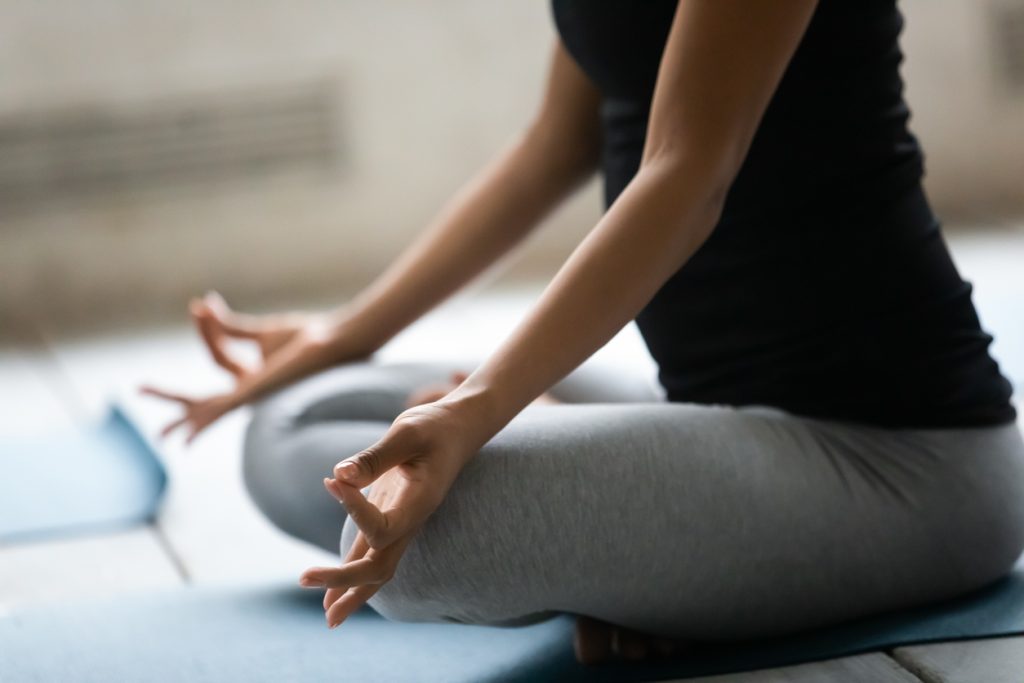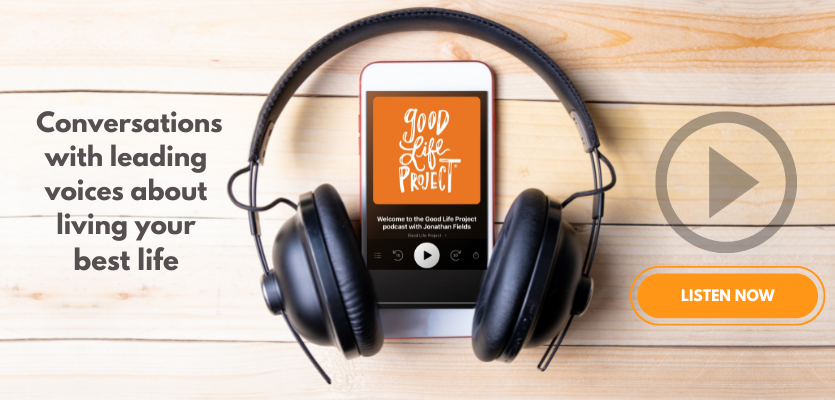Anxiety and stress have (understandably) increased dramatically over the past few years, with multiple studies showing that people have become more anxious year over year. The Calm app and Headspace app have been downloaded over 165 million times, combined –– clearly, we’re all looking for a way to chill out.
But what if that way to calm was closer than you think? What if you could tap into it at-will, no app or class required, even when everything feels out of control?
It turns out that you can. There’s no big secret to it –– but there is a lot of science. Let’s talk about 7 practices that can help you feel calmer now, and, with practice, even cultivate a cumulative calm that radiates out through the rest of your life.
7 Calming Strategies (Backed by Science)
Practice 1: Movement
Call it exercise, working out, activities, or adventuring, movement of any kind is a quick gateway into calm — and we’re not just talking about a temporary runner’s high. Movement literally changes your brain, creating this neurochemical called brain-derived neurotrophic factor (BDNF) that’s really important for keeping the parts of your brain that regulate emotion working the way you want them to.
“Low levels of BDNF protein … results in a smaller hippocampus, abnormal fear extinction, anxiety-related behaviors, and reduced efficacy of antidepressants.” (Frontiers in Psychology)
What’s more, movement of any kind helps shift your nervous system from the sympathetic state (aka fight, flight, freeze, or fawn) into the parasympathetic state, where you feel relaxed.
And, the best part? You don’t have to run a 7-minute mile or devote your life to the gym (unless you’re into that.) The main factor for success isn’t effort, it’s mindfulness. Moving mindfully and staying present, no matter what you’re doing, helps you drop into flow state, which is profoundly stilling and rejuvenating.

Practice 2: Use Your Breath
There’s a reason why breathwork has been part of many healing traditions for thousands of years — it plays a central role in your stress response. Just think about how your breath gets shallow and irregular when you’re stressed, and slower and more evenly paced when you’re calm.
This all happens automatically, of course. But the cool thing is that you can actively use your breath to upregulate or downregulate your nervous system in just a few minutes. Taking deep breaths stimulates your vagus nerve, which in turn makes you feel calm.
“When the vagus nerve is stimulated, calmness pervades the body: the heart rate slows and becomes regular; blood pressure decreases; muscles relax. When the vagus nerve informs the brain of these changes, it, too, relaxes, increasing feelings of peacefulness. Thus, the technique works through both neurobiological and psychological mechanisms.” (Scientific American)
Really think about that for a sec… you can actually shift between the modes of your nervous system at will. Talk about powerful!
There’s loads of ways you can do this, of course, but here are three of our favorites:
- 1:2 Breathing Technique: This one’s really simple. Find a comfortable position, then breathe in through your nose for two counts, and out for four counts.
- Box Breathing Technique: This is also sometimes called square breathing, because you make four equally spaced “sides” to each breath. To do it, through your nose, breathe in for two-four counts, pause for the same counts, breathe out for the same counts, and pause for the same counts.
- Teardrop Breathing Technique: The pause in between breaths is where we find grace –– that’s why Jonathan created a technique called Teardrop Breathing. You breathe through your nose in for two counts, pause for two counts, breathe out for four counts, and pause for four counts.
Each of these techniques brings your breath pacing way down from about 15 or so breaths a minute to around 6, which, according to research, is right where you want to be:
“Autonomically optimised respiration” would appear to be in the band of 6–10 breaths per minute.” (Breathe)
Take your time, listen to your body, and adapt according to what feels safe and comfortable to you. And, be mindful if you have blood pressure sensitivity or if you are pregnant, yYou want to avoid feeling dizzy or nauseous. As with all of these techniques, breathing can be powerful, if you have any concerns, be sure to check with your healthcare provider first.
Practice 3: Listen to music you love
You already know music affects your mood — otherwise why would we bother creating road trip playlists? — but you might not know the extent to which it affects your nervous system. Just like intentional breathing, music can move you from sympathetic to parasympathetic activation.
In fact, research shows that listening to relaxing music was actually hugely effective at reducing stress and promoting calm before, during, and after medical procedures!
Researchers are still figuring out the exact mechanism here, but it appears to be connected to how music interacts with emotions and memory, increasing positive emotions, decreasing negative ones, and activating both explicit memory (the stuff you try to remember) and implicit memory (your reactive, unintentional memory).
The most interesting part? It doesn’t actually matter what kind of music. It’s about what works for you, with studies showing that “favorable effect of music is maintained for both types of music, the most important element being the satisfaction of the listener.” (Psychology)
Practice 4: Try vocal toning
Vocal toning is a fancy way of saying “making noises intentionally.” It’s the kind of thing you do when you hum, or chant “om” in a group, or when you’re singing along with the radio and don’t know all the words, so you just sort of let your voice make sounds.
It turns out that vocal toning can have a profound effect on your stress levels, with studies showing that its effective at reducing intrusive thoughts and mind-wandering, and that it’s even better than mindfulness at reducing stress, anxiety, and heart rate variability, possibly because “sound vibrations [stimulate] the auricular branches of the vagal nerve with resultant effects on brain activation.” (Neuroregulation)
Plus, vocal toning tends to slow your breath rate down dramatically, often halving it, which of course you now know has a huge effect on your anxiety levels. Think of it as a shortcut to a parasympathetic state.
Practice 5: Journaling
The act of putting pen to paper might not seem like much, but it’s a powerful way to clear your mind and tap into calm. It’s a great way to get distracting or distressing thoughts out of your mind, increase mindfulness, and increase calm, even when things feel really tough. In fact, one study found that journaling was “found to have a more positive effect for participants who initially had higher levels of psychological distress.” (The Arts in Psychotherapy)
One tried-and-true practice is Morning Pages, created by Julia Cameron, the author of The Artist’s Way and one of our favorite GLP Podcast guests. This simple practice of writing out three pages longhand as soon as you wake up has literally changed tens of millions of people’s lives — perhaps because it’s such a good way to come face to face with yourself.
Julia describes it:
“Pages clarify our yearnings. They keep an eye on our goals. They may provoke us, coax us, comfort us, even cajole us, as well as prioritize and synchronize the day at hand. If we are drifting, the pages will point that out. They will point the way True North. Each morning, as we face the page, we meet ourselves. The pages give us a place to vent and a place to dream. They are intended for no eyes but our own.”
(The Miracle of Morning Pages: Everything You Always Wanted to Know About the Most Important Artist’s Way Tool)

Practice 6: Spending Time in Nature
Our species has spent most of its existence in close proximity with nature –– so it’s no wonder we’re wired to feel better for spending time outside:
“Proximity to greenspace has been associated with lower levels of stress and reduced symptomology for depression and anxiety…” (Frontiers in Psychology)
(This is called the biophilia hypothesis, by the way.)
In fact, just hearing a recording of nature sounds can shift your nervous system into parasympathetic mode, and being able to look out your window at any form of nature can trigger a calming effect:
“[Research] confirmed that viewing natural scenery led to more relaxed body responses.” (Scientific Reports)
Of course, actually getting out in nature and being around plants is even better, downregulating your nervous system, decreasing inflammatory markers in your body, and improving the health of your gut microbiome, which is also closely connected to your mood via the gut-brain-skin axis.
Practice 7: Mindfulness
People often have a lot of baggage about mindfulness — and often a lot of guilt over how they “can’t” seem to do it. The truth is, mindfulness is a practice and a way of being, so you might want to reframe it to something more like “the art of paying attention”.
It’s fantastic for training your mind in:
Focused attention: mindfulness meditation is all about noticing where your mind is, and bringing it back to a particular focus. The more you do it, the easier it gets.
Open monitoring: this is the practice of being completely open to everything that’s going on inside and outside you, with no judgment, just neutral attention
Thought-dropping: this is the practice of noticing where your mind is, naming the thought, releasing it, and returning to your focus.
All three are great skills to have regardless, and they’re amazing for creating calm, because they bring you down into the present moment, help you maintain that focus, and give you the training in dropping unhelpful or stressful thoughts. In fact, a meta-analysis of over 200 studies on mindfulness found that it’s “especially effective for reducing anxiety, depression, and stress.” (Clinical Psychology Review)
Let’s recap:
–– We’re all pretty stressed out, and it’s not likely that the external factors involved are going to change all that much. But, you can shift into calm at will by leveraging the very same biology that’s stressing you out.
–– Any kind of movement practice shifts your brain and body into a calmer state, with mindfulness (not intense amounts of effort) being the key.
–– Deliberate breathing can shift your nervous system into “rest and digest” mode in a matter of minutes.
–– Listening to music you love elicits significant changes in your mood –– no matter what kind of music it is!
–– Vocal toning (aka making sounds on purpose) has a similar effect.
–– Journaling is a great practice to get stressful thoughts of of your head, especially if you do Morning Pages.
–– Spending time in nature, looking at nature, or even being around your houseplants has a tangible effect on your nervous system, immune response, and mood.
–– Mindfulness is a fantastic way to train your brain so you can navigate or move away from stress-inducing thoughts at-will.
There are so many things you can do to help find calm, but the most important thing is to choose one, and try it out. Pick one off this list and give it a try today –– your body, mind, and soul will thank you for it.
And of course we’re here to help! Join us on the GLP podcast to learn more about cultivating calm, and do a guided meditation with Jonathan.




